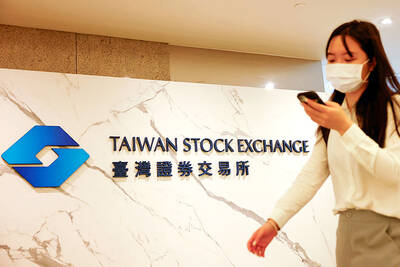Yang Ming Marine Transport Corp (陽明海運), the nation’s No. 2 container shipper, is considering making capacity adjustments to cope with the global economic slowdown, a company statement said.
Yang Ming said that members of the CKYH Alliance — which also includes Hong Kong’s Cosco Pacific Ltd (中遠太平洋), Japan’s Kawasaki Kisen Kaisha Ltd and South Korea’s Hanjin Shipping Co — have agreed to cut shipping capacity by between 9 percent and 18 percent on various routes, beginning later this month, the statement posted on Yang Ming’s Web site on Thursday said.
Yang Ming and its shipping peers are facing a global economic downturn that has slashed shipping traffic and freight rates, and prompted AP Moeller-Maersk A/S, the world’s largest, to revise downward its full-year sales forecast on Wednesday.
“CKYH is now conducting an extensive study to further restructure the Asia-East Mediterranean services, including the Aegean Sea Direct Express service,” Yang Ming said in the statement.
Shares of Yang Ming rose 0.9 percent to NT$10.95 yesterday. Evergreen Marine Corp (長榮海運), the nation’s biggest shipping line, saw its shares unchanged at NT$17.25, while Wan Hai Lines Ltd (萬海航運), the nation’s third-largest shipper by market value, rose 1.4 percent to NT$14.25, the stock exchange’s data showed.
Yang Ming’s share price has risen 20.2 percent so far this month, buoyed by prospects of direct cross-strait links after representatives of both sides signed an agreement on Nov. 4 to open 11 ports in Taiwan and 63 ports in China.
Yang Ming owns 98 vessels, including 85 container ships and 13 Panamax vessels, ranking it No. 13 worldwide. Trans-Pacific routes account for more than 44 percent of the Taiwanese shipper’s operations, followed by European routes at 34 percent and Asian routes at about 22 percent, Macquarie Securities’ statistics showed.
In the CKYH statement issued on Thursday, Yang Ming said the alliance would start in the middle of this month to lower shipping capacity on the north trans-Atlantic route between the US and Europe by approximately 18 percent.
In addition, the alliance would cut capacity on the Pacific southwest route by between 13 percent and 15 percent through the termination of services linking Mediterranean, Asia and the US in early next year.
The alliance would also reduce its weekly capacity to northern Europe by about 9 percent after the suspension of its express service on the China-northwest Europe route at the end of January, the statement said.
Last month, the alliance suspended its all-water service between Asia and the US East Coast and its Asia/East Mediterranean express service.
Yang Ming’s revenue last month fell 2.7 percent to NT$10.28 billion from a year earlier and its first 10-month revenue grew 7.2 percent to NT$100.2 billion.
While the shipper’s strong dry bulk business has helped offset its weak container shipping operations, Yang Ming’s net profit plunged 53.4 percent year-on-year to NT$1.6 billion in the first nine months of this year, reflecting the impact of high fuel costs and falling freight rates.
Shares of Yang Ming have dropped 56.4 percent so far this year, compared with a drop of 47.7 percent on the benchmark TAIEX over the same period, the stock exchange's tallies showed.

The New Taiwan dollar is on the verge of overtaking the yuan as Asia’s best carry-trade target given its lower risk of interest-rate and currency volatility. A strategy of borrowing the New Taiwan dollar to invest in higher-yielding alternatives has generated the second-highest return over the past month among Asian currencies behind the yuan, based on the Sharpe ratio that measures risk-adjusted relative returns. The New Taiwan dollar may soon replace its Chinese peer as the region’s favored carry trade tool, analysts say, citing Beijing’s efforts to support the yuan that can create wild swings in borrowing costs. In contrast,

Nvidia Corp’s demand for advanced packaging from Taiwan Semiconductor Manufacturing Co (TSMC, 台積電) remains strong though the kind of technology it needs is changing, Nvidia CEO Jensen Huang (黃仁勳) said yesterday, after he was asked whether the company was cutting orders. Nvidia’s most advanced artificial intelligence (AI) chip, Blackwell, consists of multiple chips glued together using a complex chip-on-wafer-on-substrate (CoWoS) advanced packaging technology offered by TSMC, Nvidia’s main contract chipmaker. “As we move into Blackwell, we will use largely CoWoS-L. Of course, we’re still manufacturing Hopper, and Hopper will use CowoS-S. We will also transition the CoWoS-S capacity to CoWos-L,” Huang said

VERTICAL INTEGRATION: The US fabless company’s acquisition of the data center manufacturer would not affect market competition, the Fair Trade Commission said The Fair Trade Commission has approved Advanced Micro Devices Inc’s (AMD) bid to fully acquire ZT International Group Inc for US$4.9 billion, saying it would not hamper market competition. As AMD is a fabless company that designs central processing units (CPUs) used in consumer electronics and servers, while ZT is a data center manufacturer, the vertical integration would not affect market competition, the commission said in a statement yesterday. ZT counts hyperscalers such as Microsoft Corp, Amazon.com Inc and Google among its major clients and plays a minor role in deciding the specifications of data centers, given the strong bargaining power of

TARIFF SURGE: The strong performance could be attributed to the growing artificial intelligence device market and mass orders ahead of potential US tariffs, analysts said The combined revenue of companies listed on the Taiwan Stock Exchange and the Taipei Exchange for the whole of last year totaled NT$44.66 trillion (US$1.35 trillion), up 12.8 percent year-on-year and hit a record high, data compiled by investment consulting firm CMoney showed on Saturday. The result came after listed firms reported a 23.92 percent annual increase in combined revenue for last month at NT$4.1 trillion, the second-highest for the month of December on record, and posted a 15.63 percent rise in combined revenue for the December quarter at NT$12.25 billion, the highest quarterly figure ever, the data showed. Analysts attributed the